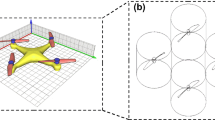Abstract
A realistic application of advanced structural and multi-objective optimization for the design of a fully assembled aircraft powerplant installation is presented. As opposed to the classical design process of powerplant installation that does not consider the influence of pylon sizing over engine efficiency, we develop in the present a fully integrated approach where both pylon and compressor intercase are designed at once. The main objective is to consider the impact of weight over tip clearance performance criterion and see how these two objectives are antagonistic. In this work, we perform in the same design session tasks traditionally devoted to the airframe manufacturer and aero-engine manufacturer. The overall weight of the assembly is minimized with respect to Specific Fuel Consumption (SFC) criterion. One interesting aspect of the process is that SFC criterion is based on highly proprietary models and its simulation and call within an optimization process is made available through the development of a webservice. One major phenomenon to consider in both pylon and engine design is Fan Blade Off (FBO) event, i.e. the sudden release of a blade. This event causes high impact loads and must be considered carefully in the design. Such a simulation is not an easy task and several nonlinear phenomena must be addressed (e.g. rotordynamics), not to mention the integration of this nonlinear dynamic response in a static structural optimization process. This article describes how the design of the full assembly is performed taking into account both objectives. Such a problem lies in multi-objective optimization field and then we describe the method we use to solve such a problem. The simulation of an FBO post-impact rotor dynamics is also described and we end up with the final results that show the influence of pylon-engine weight sizing over SFC.












Similar content being viewed by others
Notes
Thrust links can not be used to derive FBO-loads this way as their maximum loading is attained for normal engine regime.
See for instance http://www.jet-engine.net/.
(\(W_{\textrm {min}}, SFC_{\textrm {min}}\)) is known as the utopia point (usually not reachable) and (\(W_{\textrm {max}}, SFC_{\textrm {max}}\)) is known as the nadir point.
Still possible though.
References
Anonymous (2012) Demonstration problems manual: MSC Nastran 2012. MacNeal-Schwendler Corporation
Bettebghor D, Bartoli N, Grihon S, Morlier J, Samuelides M (2011) Surrogate modeling approximation using a mixture of experts based on em joint estimation. Struct Multidisc Optim 43(2):243–259
Cardoso JB, Arora JS (1992) Design sensitivity analysis of nonlinear dynamic response of structural and mechanical systems. Struct Multidisc Optim 4(1):37–46
Carney KS, Lawrence C, Carney DV (2002) Aircraft engine blade-out dynamics. In: Seventh international LS-DYNA users conference. Livermore Software Technology Corporation, Livermore, pp 14–17
Cho S, Choi KK (2000) Design sensitivity analysis and optimization of non-linear transient dynamics. Part 1: sizing design. Int J Numer Methods Eng 48(3):351–373
Choi KK, Kim NH (2005) Structural sensitivity analysis and optimization: nonlinear systems and applications, vol 2. Springer, New York
Forrester AIJ, Keane AJ (2009) Recent advances in surrogate-based optimization. Prog Aerosp Sci 45(1):50–79
Friedman J, Hastie T, Tibshirani R (2001) The elements of statistical learning, vol 1. Springer Series of Statistics
Grihon S (2005) Pylon design optimisation. In: Forum 1, VIVACE project
Haftka RT, Adelman HM (1989) Recent developments in structural sensitivity analysis. Struct Multidisc Optim 1(3):137–151
Heidari M, Carlson DL, Sinha S, Sadeghi R, Heydari C, Bayoumi H, Son J (2008) An efficient multi-disciplinary simulation of engine fan-blade out event using MD NASTRAN. American Institute of Aeronautics and Astronautics, New York
Heidari MA, Carlson DL, Yantis T (2002) Rotor-dynamics analysis process. In: MSC Worldwide aerospace conference and technology showcase, 8–10 April 2002, pp 1–16
Hsieh CC, Arora JS (1984) Design sensitivity analysis and optimization of dynamic response. Comput Methods Appl Mech Eng 43(2):195–219
Husband JB (2007) Developing an efficient FEM structural simulation of a fan blade off test in a turbofan jet engine. PhD thesis, University of Saskatchewan
Jain R (2010) Prediction of transient loads and perforation of engine casing during blade-off event of fan rotor assembly. In: Proceedings of the IMPLAST 2010 conference, Providence, Rhode Island, USA, 12–14 October 2010
Kang BS, Park GJ, Arora JS (2006) A review of optimization of structures subjected to transient loads. Struct Multidisc Optim 31(2):81–95
Kennedy MC, O’Hagan A (2000) Predicting the output from a complex computer code when fast approximations are available. Biometrika 87(1):1–13
Kim YI, Park GJ (2010) Nonlinear dynamic response structural optimization using equivalent static loads. Comput Methods Appl Mech Eng 199(9–12):660–676
Kim YI, Park GJ, Kolonay RM, Blair M, Canfield RA (2009) Nonlinear dynamic response structural optimization of a joined-wing using equivalent static loads. J Aircr 46(3):821–831
Lattime SB, Steinetz BM, NASA Glenn Research Center (2002) Turbine engine clearance control systems: current practices and future directions. National Aeronautics and Space Administration, Glenn Research Center
Lawrence C, Carney K, Gallardo V (2003) A study of fan stage/casing interaction models. National Aeronautics and Space Administration, Glenn Research Center
Lawrence C, Carney KS, Gallardo V, NASA Glenn Research Center (2001) Simulation of aircraft engine blade-out structural dynamics. National Aeronautics and Space Administration, Glenn Research Center
Marler RT, Arora JS (2004) Survey of multi-objective optimization methods for engineering. Struct Multidisc Optim 26(6):369–395
Michels G, Genberg V, Doyle K (2004) Using the DRESP3 to improve multidisciplinary optimization. In: MSC software, pp 2004–2030
Miettinen K (1999) Nonlinear multiobjective optimization. Springer, New York
Niu MCY (1999) Airframe structural design: practical design information and data on aircraft structures. Recherche 67:02
Park GJ (2011) Technical overview of the equivalent static loads method for non-linear static response structural optimization. Struct Multidisc Optim 43(3):319–337
Rao SS, Freiheit TI (1991) A modified game theory approach to multiobjective optimization. J Mech Des 113:286
Saaty TL (1977) A scaling method for priorities in hierarchical structures. J Math Psychol 15(3):234–281
Sinha SK, Dorbala S (2009) Dynamic loads in the fan containment structure of a turbofan engine. J Aerosp Eng 22:260
Toal DJJ, Bressloff NW, Keane AJ, Holden CME (2011) The development of a hybridized particle swarm for kriging hyperparameter tuning. Eng Optim 43(6):675–699
Tsay JJ, Arora JS (1990) Nonlinear structural design sensitivity analysis for path dependent problems. Part 1: general theory. Comput Methods Appl Mech Eng 81(2):183–208
Vance JM (1988) Rotordynamics of turbomachinery. Wiley-Interscience, New York
Vance JM, Murphy B, Zeidan F (2010) Machinery vibration and rotordynamics. Wiley Online Library
Acknowledgements
The research leading to the presented results received funding from the European Community Seventh Framework Programme (FP7/2007-2013) (www.crescendo-fp7.eu) under grant agreement no. 234344. Authors are very thankful to engineers and researchers that helped to define and perform this work, particularly Praful Soneji and Richard Golder from Rolls–Royce, UK and Stéphane Grihon from Airbus, France.
Author information
Authors and Affiliations
Corresponding author
Appendices
Appendix A: Preliminary modal analysis
In this short section, we simply describe the numerical results obtained for modal analysis of the whole structure. As outlined in Section 5 one may observe numerical resonance issues when the spinning speed of rotors approaches natural frequencies of the structure. We than ran a preliminary modal analysis to ensure that the rotor nominal spinning speed is not near any natural frequencies. As noted in the article, the nominal rotor speed of the rotor is 50 Hz and the windmill speed is 10 Hz. Both frequencies are not close to a natural eigenfrequencies of the assembly (Table 1). For sake of completeness, we also depicted the shapes of the first natural modes of the assembly.
Appendix B: Implementation details for FBO rotor dynamics simulation and optimization session
We briefly describe here the different solutions that we used to achieve our bi-objective optimization. The final assembled model was a MSC.Nastran FEM model. Based on our previous experience, we ran the optimization with MSC.Nastran solution SOL200. More precisely we used the different items:
-
Classical SOL101 and SOL103 were used first to run and validate our final finite element model. SOL101 was used first to ensure that no major issue nor mistake was in the model. SOL103 was used to compute the first fundamental modes of the assembled structure and get the first fundamental frequencies to get rid off resonance issue while performing rotordynamics issue. SOL101 and SOL103 solutions were used for the material linear part of the model: engine and pylon assembly (Fig. 13).
-
We first ran Fan Blade Off event simulation based on Rolls–Royce, UK entries. To that end, we started with linear modeling and ran transient and direct dynamics analysis solutions from MSC: SOL109 and SOL112. When facing unreasonable output responses, we enriched our model and reaches a more realistic model by integrating nacelle and rotordynamics effects.
-
Whenever the nacelle was added, we had to turn to nonlinear dynamics solution: SOL129. The same way, we used in this solution the rotordynamics Nastran cards: RGYRO, ROTORG, etc. As already noticed, simulation results were similar to responses that we would expect for such a simulation, however, for our design optimization, we needed to extract forces at pylon-to-wing and engine-to-pylon attachment. This could not be done in SOL129. We then had to use SOL400 for nonlinear dynamics simulation to retrieve Nastran SPCFORCES cards.
-
To create our equivalent FBO static load cases, we used classical text processing languages such as shell scripts and awk. MATLAB has also been used to post-process results.
-
Regarding SFC surrogate model, we could not directly use the webservice in SOL200. Indeed, such an integration seems hardly feasibleFootnote 4 since a MATLAB executable is not suited to integration in the external response driver of SOL200. Such a technology is indeed easier with the source code. This is why we did use a surrogate model of the surrogate model, to get our known source code. To approximate the surrogate model of SFC, we used a different strategy than the one used by University of Southampton that was kriging models. We used a mixture of experts strategy, described in Bettebghor et al. (2011).
-
Optimization was performed with SOL200. The SFC surrogate model was integrated using DRESP3 card, a quite popular tool for multidisciplinary optimization, see for instance Michels et al. (2004). The Pareto front was then obtained by automating the process of changing the weighting factor in a scalar optimization through standard shell scripting.
Appendix C: Transient loads history in attachments
We can not give all the transient history for all attachments. However, for sake of comparison, for instance with Husband (2007), we present in this section the history of loads for pylon-to-wing attachments. As it can be observed in Fig. 14 when comparing with results in Husband (2007), forces are quite similar in terms of magnitude and pseudo-period.
Rights and permissions
About this article
Cite this article
Bettebghor, D., Blondeau, C., Toal, D. et al. Bi-objective optimization of pylon-engine-nacelle assembly: weight vs. tip clearance criterion. Struct Multidisc Optim 48, 637–652 (2013). https://doi.org/10.1007/s00158-013-0908-7
Received:
Revised:
Accepted:
Published:
Issue Date:
DOI: https://doi.org/10.1007/s00158-013-0908-7






